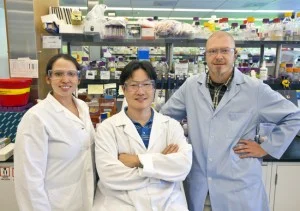The rising economic and political costs of foreign oil, coupled with climate-change fears, have been driving the search for renewable, alternative transportation fuels in the United States.
A chief focus of research has been on “drop-in fuels” made from the biomass of perennial grasses and other nonfood plants or agricultural waste, which have the potential – as the name implies – to replace gasoline, diesel and jet fuels in today’s engines.

Researchers with the U.S Department of Energy’s Joint BioEnergy Institute (JBEI), a scientific consortium led by Lawrence Berkeley National Laboratory (Berkeley Lab), have identified a potential new advanced biofuel that they say could replace Number 2 (D2) diesel fuel, today’s standard fuel for diesel engines.
In an article entitled, “Identification and microbial production of a terpene-based advanced biofuel,” published in the journal Nature Communications, the team describes how it used bioengineered strains of the Escherichia coli (e. coli) bacteria and a yeast to produce a precursor to bisabolane, a chemical compound similar to those used in fragrances and flavorings.
According to Taek Soon Lee (pictured above, center, with colleagues Pamela Peralta-Yahya and Mario Ouellet), who directs JBEI’s metabolic engineering program, Bisabolane has properties almost identical to D2 diesel, but much lower freezing and cloud points, which, he said, should be advantageous for its use as a fuel.
“This work is also a proof-of-principle for advanced biofuels research in that we’ve shown that we can design a biofuel target, evaluate this fuel target, and produce the fuel with microbes that we’ve engineered,” said Lee.

The team is now preparing to make gallons of bisabolane for tests in actual diesel engines, using the new fermentation facilities at the Berkeley Lab’s Advanced Biofuels Process Demonstration Unit (ABPDU), which opened this summer.
Ultimately, the team aims to replace the chemical processing step with an enzyme engineered into the E.coli and yeast, so that all of the chemistry can be performed within the microbes.






